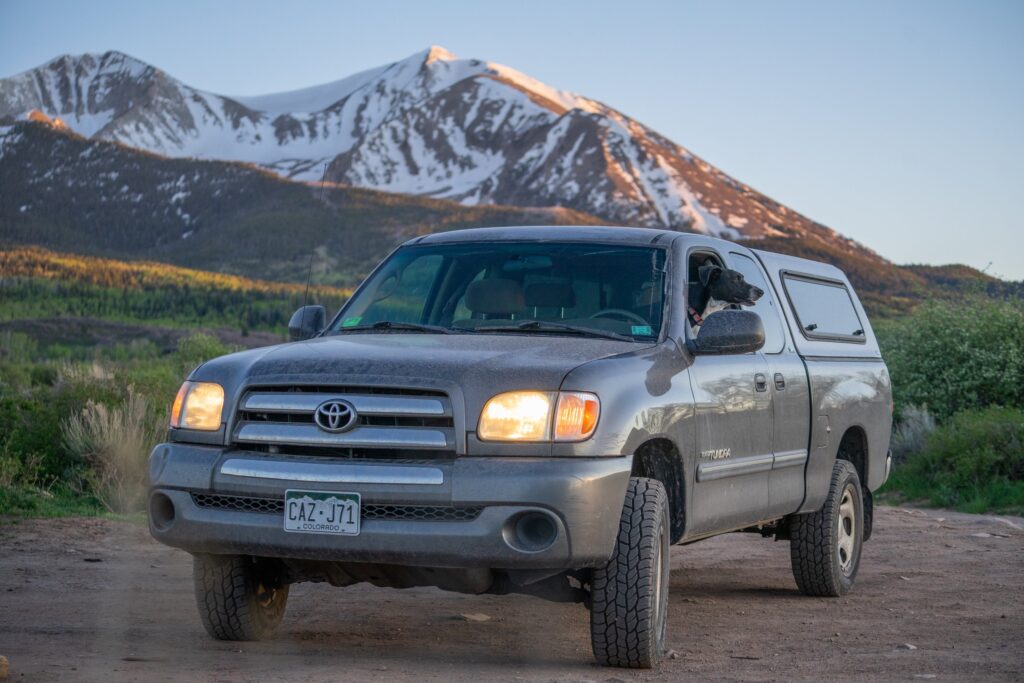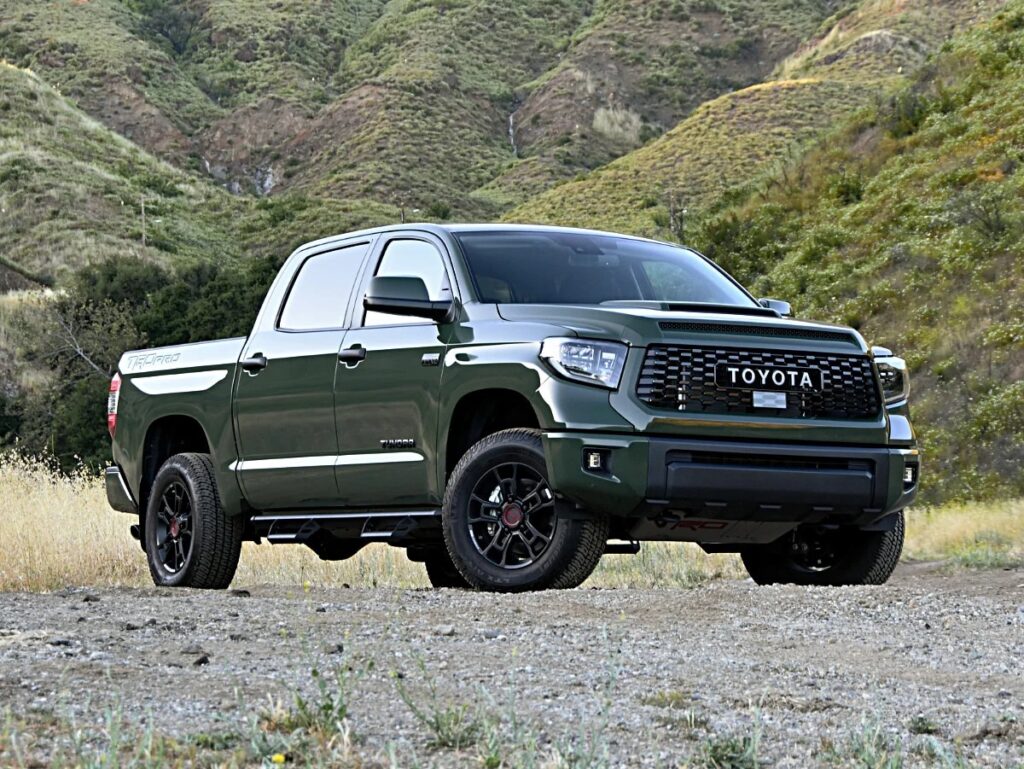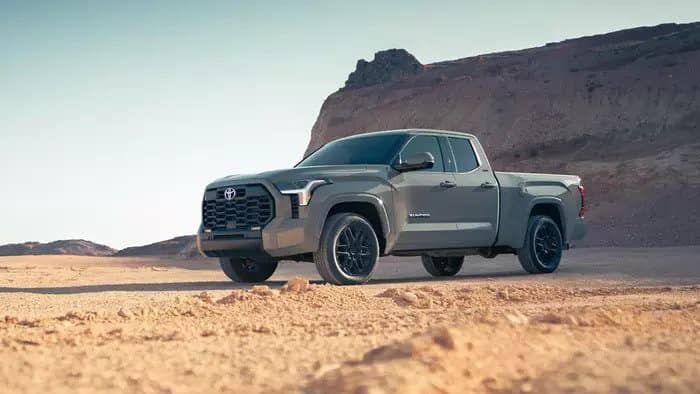
The American Truck Market
For 50+ years, American manufacturers had dominated the pickup truck market. The Pickup truck segment has always demanded the most capable and durable vehicles, and American brands Ford, GM, and Dodge have been in a long-time arms race to hold the title of the toughest truck. In 1999 after decades of growth from the Japanese Auto manufacturer, including some success in the midsized truck market. Toyota decided it was time to take on the American Champs for the truck crown. The Toyota Tundra made its debut in 1999 as Toyota’s first full-sized truck built specifically for the North American market. Born from the desire to offer a robust and capable alternative to traditional American trucks, the Tundra quickly gained traction and respect among truck enthusiasts.
The Toyota brass were clever about their approach. They did not introduce a truck that was going to be the biggest, most badass heavy-duty work truck. Instead, they concentrated all their resources on building a highly capable and reliable half-ton full-size pick, and the Tundra was born.
What could Toyota offer to set the Tundra apart?
The first-generation Tundra was slightly smaller than its American rivals, attracting some and turning off others. For American buyers who wanted the capabilities of a full-size truck but still wanted to be able to easily park it in their grocery store parking lots, the slightly smaller, nimble design appealed to many that could let go of a macho, bigger is better attitude.
As for powertrain, the first gen Tundra offered two engine choices: a 3.4L V6 and a 4.7L V8. While these engines provided respectable power and performance, they fell slightly short of the output offered by the larger V8 engines in American pickups. Some American trucks offered a broader range of engine options, including more powerful V8s and even diesel engines, providing greater flexibility for buyers with specific towing and hauling needs. These slightly smaller engines delivered competitive performance in towing and payload. The first-generation Tundra was competitive with its American counterparts in terms of towing and payload capacity. Depending on the configuration, the Tundra could tow up to around 7,000 to 7,500 pounds and had a payload capacity of approximately 1,400 to 1,700 pounds.
So how could Toyota crack the door open on the American truck market? The leveraged their manufacturing and engineering prowess to build the most reliable trucks ever to hit American roads.

5 Reasons the Toyota Tundra is more reliable than other trucks.
Toyota’s reputation for reliability stems from several key factors that contribute to the overall durability and dependability of their vehicles:
- Quality Manufacturing and Engineering: Toyota strongly emphasizes quality control and precision engineering. They have implemented rigorous manufacturing processes and standards to ensure consistent build quality and reliability throughout their vehicle lineup. Attention to detail and a commitment to excellence are fundamental principles that Toyota adheres to in every aspect of its production.
- Robust Testing and Quality Assurance: Before a Toyota vehicle reaches the market, it undergoes extensive testing and quality assurance measures. Prototypes and pre-production models are subjected to rigorous testing under various conditions, including extreme temperatures, rough terrains, and simulated real-world scenarios. This thorough testing process helps identify and rectify any potential issues, resulting in a more reliable and durable final product.
- Reliability-focused Design Philosophy: Toyota designs its vehicles with a focus on longevity and reliability. They prioritize practicality, simplicity, and durability in their engineering, choosing proven technologies and components over overly complex or untested innovations. This conservative approach contributes to the overall reliability and ease of maintenance of Toyota vehicles.
- Continuous Improvement and Feedback: Toyota has a culture of continuous improvement. They actively seek customer feedback and conduct extensive post-production analysis to identify areas for enhancement. This feedback loop allows Toyota to address any potential issues promptly and implement improvements in subsequent models. This commitment to constant refinement contributes to their overall reliability.
- Extensive Research and Development: Toyota invests heavily in research and development to advance automotive technologies and improve vehicle reliability. They focus on innovative solutions to enhance fuel efficiency, safety, and durability. This commitment to technological advancement, combined with their thorough testing and validation processes, contributes to the overall reliability of Toyota vehicles.
Toyota Tundra Generation Differences
First Generation Toyota Tundra (2000-2006)

The first-generation Tundra laid the foundation for Toyota’s entry into the full-sized truck segment. It offered a range of engine options, including V6 and V8 powerplants, and had a maximum towing capacity of up to 7,200 pounds. However, critics felt that it fell slightly short in terms of overall capability and interior refinement compared to its American rivals.
The first-generation Tundra initially faced an uphill battle against well-established American truck manufacturers. However, Toyota’s reputation for reliability and quality gradually gained traction among consumers, leading to increased sales and market share.
During its early years, the Tundra experienced steady growth in sales as buyers recognized its durability, towing capacity, and overall value. The introduction of the Double Cab model in 2004, which offered more passenger space and four full-sized doors, further bolstered its appeal to a broader range of buyers.
While specific sales figures for individual years of the first-generation Tundra are not readily available, it is worth noting that Toyota reported over 100,000 units sold annually during certain years of its production. This solid performance demonstrated the growing acceptance and popularity of the Tundra in the American market.
Additionally, the first-generation Tundra received positive reviews from consumers and automotive publications alike, further boosting its sales and reputation. Its combination of reliability, capable performance, and Toyota’s strong brand image helped to carve out a significant share of the competitive full-sized truck segment.
Ultimately, the first-generation Toyota Tundra made significant strides in capturing the attention and loyalty of American truck buyers. It set the stage for future generations of the Tundra and laid the foundation for Toyota’s continued success in the highly competitive American truck market.
Second Generation Toyota Tundra (2007-2021)

The second-generation Tundra, unveiled in 2007, represented a significant leap forward in size, power, and refinement. It boasted a bolder design, increased towing capacity of up to 10,200 pounds, and a variety of trim levels catering to different needs and preferences. Toyota’s focus on improving interior comfort and technological features made the second-generation Tundra more competitive in the market.
You will notice Toyota has some of the longest product cycles in the automotive industry and the 2nd gen Tundra was one of the longest of any high-production vehicle. While some might say that Toyota could have been innovating the model over this 14-year period their approach was one of subtle evolution. There we slight drivetrain, interior, and body changes that continued to approve the truck while these refinements created a drivetrain considered the most reliable in the world with tons of parts availability.
The second-generation Toyota Tundra offered a range of models to cater to various customer preferences and needs. Toyota introduced several trim levels and configurations for the second-generation Tundra throughout its production run. While the exact number of models varied by year and market, I can provide an overview of the available main variants.
SR:
The SR trim level served as the base model of the second-generation Tundra. It offered essential features and functionality while maintaining a competitive price point.
SR5:
The SR5 trim level provided additional convenience and comfort features compared to the base SR model. It often included upgraded interior materials, enhanced audio systems, and additional power accessories.
Limited:
The Limited trim level added a touch of luxury and sophistication to the Tundra. It typically featured upscale interior appointments, premium audio systems, advanced technology features, and additional safety enhancements.
Platinum:
The Platinum trim level represented the pinnacle of luxury and refinement in the second-generation Tundra lineup. It offered premium amenities such as leather upholstery, heated and ventilated front seats, advanced infotainment systems, and high-end audio options.
1794 Edition:
Introduced in 2014, the 1794 Edition paid homage to the ranch where the Tundra assembly plant is located. It featured unique styling elements, premium interior appointments, and exclusive badging.
TRD Off-Road:
Toyota offered the TRD Off-Road package for buyers seeking enhanced off-road capabilities. It included features like off-road suspension, skid plates, all-terrain tires, and a locking rear differential to tackle challenging terrain.
TRD Pro:
The range-topping TRD Pro trim level was designed for serious off-road enthusiasts. It featured specialized off-road suspension components, aggressive exterior styling, upgraded tires, and additional off-road-oriented features.
Throughout the second-generation Tundra’s production, Toyota periodically introduced special editions, limited editions, and package options to diversify the model lineup further and cater to specific market demands.
Third Generation Toyota Tundra (2022-Present)

The third-generation Toyota Tundra, introduced in 2022, brought forth significant changes and improvements compared to its predecessor, the second-generation Tundra. Here are the 7 key differences between the second and third-generation Toyota Tundra.
- Redesigned Exterior:
The third-generation Tundra underwent a complete exterior redesign, featuring a more aggressive and bold appearance. It showcased a larger grille, distinctive LED headlights, a sculpted body with muscular lines, and updated taillights. The overall design aimed to project a commanding and modern presence on the road.
- All-New Platform:
The third-generation Tundra is built on an all-new platform, known as the Toyota New Global Architecture-F (TNGA-F). This platform provides improved structural rigidity, enhanced safety, and increased towing and payload capabilities compared to the previous generation.
- Powertrain Options:
The second-generation Tundra offered a range of V8 engines, including a 4.6L and 5.7L. In contrast, the third-generation Tundra introduces a new powertrain lineup. It features a standard 3.5L twin-turbo V6 engine paired with a 10-speed automatic transmission. Additionally, the third-generation Tundra introduced a hybrid powertrain option, combining a twin-turbo V6 engine with an electric motor for increased fuel efficiency and performance.
- Enhanced Technology and Connectivity:
The third-generation Tundra boasts significant advancements in technology and connectivity features. It offers a larger touchscreen infotainment system with improved graphics and functionality, compatibility with Apple CarPlay and Android Auto, and advanced driver-assistance systems for increased safety and convenience.
- Upgraded Interior:
Toyota has focused on improving interior quality and comfort in the third-generation Tundra. It features a more refined cabin with high-quality materials, enhanced seating comfort, and increased interior space for passengers and cargo. The updated interior design reflects a more modern and upscale aesthetic.
- Improved Off-Road Capability:
While the second-generation Tundra offered off-road variants like the TRD Off-Road and TRD Pro, the third-generation Tundra further enhances its off-road prowess. It introduces the Tundra TRD Pro as the ultimate off-road variant, equipped with features such as specialized off-road suspension, skid plates, all-terrain tires, and advanced off-road assist systems.
- Advanced Safety Features:
The third-generation Tundra strongly emphasizes safety with the inclusion of Toyota Safety Sense 2.5+, an advanced suite of driver-assistance technologies. This includes features like adaptive cruise control, lane-keeping assist, automatic emergency braking, and pedestrian detection.
After 22 years, Toyota’s full-size pickup certainly hasn’t come close to taking the American pickup sales crown, but it has brought new buyers into the segment and has in many ways redefined the market.
In 2022, the Toyota Tundra sold 94,429 units in the United States. This was a 15.2% increase from its sales in 2021. However, Tundra’s sales were still significantly lower than the sales of its American rivals.
The best-selling full-size pickup truck in the United States in 2022 was the Ford F-Series, which sold 653,957 units. The F-Series has been the best-selling truck in the United States for 45 consecutive years. The Chevrolet Silverado was the second best-selling truck in 2022, with sales of 513,354 units. The Ram 1500 was the third best-selling truck, with sales of 468,344 units.
Want to know what generation and model Toyota Tundra has the most horsepower? Click Here
